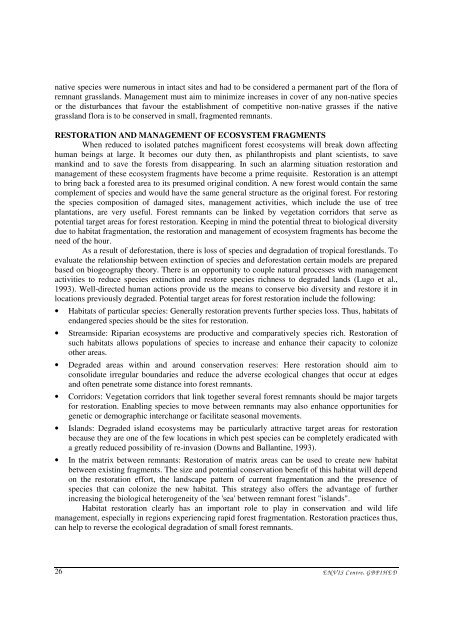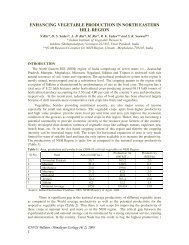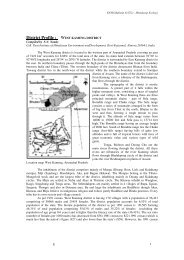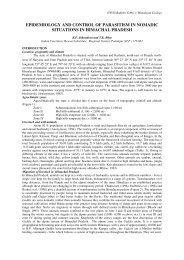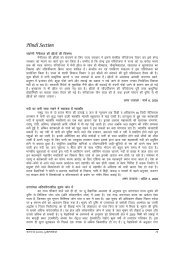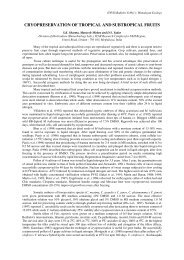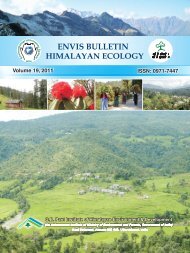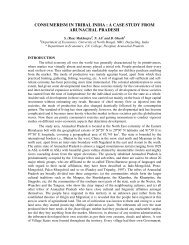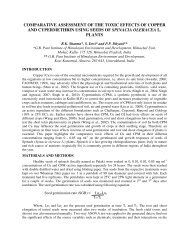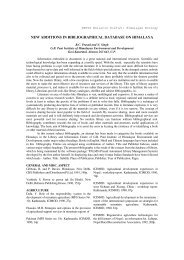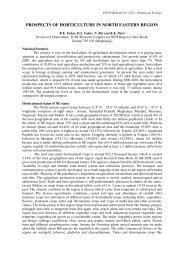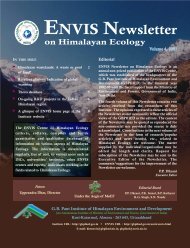native species were numerous in intact sites and had to be c<strong>on</strong>sidered a permanent part of the flora ofremnant grasslands. Management must aim to minimize increases in cover of any n<strong>on</strong>-native speciesor the disturbances that favour the establishment of competitive n<strong>on</strong>-native grasses if the nativegrassland flora is to be c<strong>on</strong>served in small, fragmented remnants.RESTORATION AND MANAGEMENT OF ECOSYSTEM FRAGMENTSWhen reduced to isolated patches magnificent forest ecosystems will break down affectinghuman beings at large. It becomes our duty then, as philanthropists and plant scientists, to savemankind and to save the forests from disappearing. In such an alarming situati<strong>on</strong> restorati<strong>on</strong> andmanagement of these ecosystem fragments have become a prime requisite. Restorati<strong>on</strong> is an attemptto bring back a forested area to its presumed original c<strong>on</strong>diti<strong>on</strong>. A new forest would c<strong>on</strong>tain the samecomplement of species and would have the same general structure as the original forest. For restoringthe species compositi<strong>on</strong> of damaged sites, management activities, which include the use of treeplantati<strong>on</strong>s, are very useful. Forest remnants can be linked by vegetati<strong>on</strong> corridors that serve aspotential target areas for forest restorati<strong>on</strong>. Keeping in mind the potential threat to biological diversitydue to habitat fragmentati<strong>on</strong>, the restorati<strong>on</strong> and management of ecosystem fragments has become theneed of the hour.As a result of deforestati<strong>on</strong>, there is loss of species and degradati<strong>on</strong> of tropical forestlands. Toevaluate the relati<strong>on</strong>ship between extincti<strong>on</strong> of species and deforestati<strong>on</strong> certain models are preparedbased <strong>on</strong> biogeography theory. There is an opportunity to couple natural processes with managementactivities to reduce species extincti<strong>on</strong> and restore species richness to degraded lands (Lugo et al.,1993). Well-directed human acti<strong>on</strong>s provide us the means to c<strong>on</strong>serve bio diversity and restore it inlocati<strong>on</strong>s previously degraded. Potential target areas for forest restorati<strong>on</strong> include the following:• Habitats of particular species: Generally restorati<strong>on</strong> prevents further species loss. Thus, habitats ofendangered species should be the sites for restorati<strong>on</strong>.• Streamside: Riparian ecosystems are productive and comparatively species rich. Restorati<strong>on</strong> ofsuch habitats allows populati<strong>on</strong>s of species to increase and enhance their capacity to col<strong>on</strong>izeother areas.• Degraded areas within and around c<strong>on</strong>servati<strong>on</strong> reserves: Here restorati<strong>on</strong> should aim toc<strong>on</strong>solidate irregular boundaries and reduce the adverse ecological changes that occur at edgesand often penetrate some distance into forest remnants.• Corridors: Vegetati<strong>on</strong> corridors that link together several forest remnants should be major targetsfor restorati<strong>on</strong>. Enabling species to move between remnants may also enhance opportunities forgenetic or demographic interchange or facilitate seas<strong>on</strong>al movements.• Islands: Degraded island ecosystems may be particularly attractive target areas for restorati<strong>on</strong>because they are <strong>on</strong>e of the few locati<strong>on</strong>s in which pest species can be completely eradicated witha greatly reduced possibility of re-invasi<strong>on</strong> (Downs and Ballantine, 1993).• In the matrix between remnants: Restorati<strong>on</strong> of matrix areas can be used to create new habitatbetween existing fragments. The size and potential c<strong>on</strong>servati<strong>on</strong> benefit of this habitat will depend<strong>on</strong> the restorati<strong>on</strong> effort, the landscape pattern of current fragmentati<strong>on</strong> and the presence ofspecies that can col<strong>on</strong>ize the new habitat. This strategy also offers the advantage of furtherincreasing the biological heterogeneity of the 'sea' between remnant forest "islands".Habitat restorati<strong>on</strong> clearly has an important role to play in c<strong>on</strong>servati<strong>on</strong> and wild lifemanagement, especially in regi<strong>on</strong>s experiencing rapid forest fragmentati<strong>on</strong>. Restorati<strong>on</strong> practices thus,can help to reverse the ecological degradati<strong>on</strong> of small forest remnants.26E N V IS C entre, G B P IH E D
Management acti<strong>on</strong>sLand management encompasses a diverse range of activities. Restorati<strong>on</strong> measures canimprove the viability of small forest remnants, expand key wild life habitats, and increase landscapec<strong>on</strong>nectivity by revegetating stream margins. Forests can regenerate <strong>on</strong> denuded lands quite rapidly ifthe land is protected from fire, grazing, and encroachment, and if small forest patches have beenretained as sources of forest seeds, mycorrhizae, and seed dispersers. Intensively managed areas suchas timber plantati<strong>on</strong>s can harbour a surprisingly diverse array of native plants if natural regenerati<strong>on</strong> ispermitted in the understory. For landscape management and restorati<strong>on</strong>, especially in terms ofreducing or mitigating the effects of forest fragmentati<strong>on</strong>, various methods, tools and technologies areinvolved. Active habitat management is usually a time c<strong>on</strong>suming and expensive activity. Resourcemanagement agencies and organizati<strong>on</strong>s comm<strong>on</strong>ly operate <strong>on</strong> very limited and inadequate budgets.Thus, there is a great need to target management projects carefully and to spend scarce resourceswisely. The type and spatial c<strong>on</strong>figurati<strong>on</strong> of matrix habitats surrounding fragments can str<strong>on</strong>glyaffect the dynamics and compositi<strong>on</strong> of fragment biotas. Because the matrix is so important,reforestati<strong>on</strong> initiatives are likely to play an ever-increasing role in tropical landscape management.Management acti<strong>on</strong>s that increase the number of species <strong>on</strong> biologically impoverished ordegraded sites include:• Recycling of sewage and other n<strong>on</strong>-toxic organic wastes through degraded sites to increase soilorganic matter, stimulate soil microbial activity and accelerate natural successi<strong>on</strong>.• Use of proven reclamati<strong>on</strong> techniques in mining areas and/or derelict industrial and urban sites.• Diversificati<strong>on</strong> of habitats within agricultural landscapes through adopti<strong>on</strong> of agro-forestrysystems, maintenance of vegetati<strong>on</strong> in uncultivated corridors, or tree islands between fields, al<strong>on</strong>groads and waterways and around wetlands and other uncultivated sites.• Multiple seeding of deforested, severely degraded sites.• Use of tree plantati<strong>on</strong>s as foster ecosystems for native tree species.• C<strong>on</strong>trol of fire, unregulated livestock grazing, and excessive fuel wood collecti<strong>on</strong> to allow naturalrecovery processes to enhance biological diversity. Improving soil fertility, particularly soilorganic matter.CONCLUSIONIn c<strong>on</strong>clusi<strong>on</strong>, as we reach the turn of the present century, we find that the cumulativeimpacts of industrial civilizati<strong>on</strong> have jeopardized the future of a large number of species, leading tomass extincti<strong>on</strong>. The causes for this major catastrophe are habitat loss and fragmentati<strong>on</strong>, unplannedintroducti<strong>on</strong> of exotic species and over-exploitati<strong>on</strong> of plant and animal resources (Singh et al., 1994).Forest fragmentati<strong>on</strong> is a widespread phenomen<strong>on</strong> and is recognized as <strong>on</strong>e of the major threats toecosystems and bio - diversity. Habitat fragmentati<strong>on</strong> results in habitat loss and alterati<strong>on</strong> increasededge effects, increased isolati<strong>on</strong> of forest populati<strong>on</strong>s, and invasi<strong>on</strong> by exotic species. Fragmentati<strong>on</strong>can also restrict pollinator movement, which may reduce gene flow and result in increased inbreeding.Remnants comm<strong>on</strong>ly persist in steep inaccessible (or low productivity) areas and in areas protectedfrom fire. Many tropical regi<strong>on</strong>s exhibit an alarming combinati<strong>on</strong> of high biological endemism, severedeforestati<strong>on</strong> and inadequate protected area systems.One of the greatest challenges is the c<strong>on</strong>servati<strong>on</strong> of locally endemic species. It is thereforevital to c<strong>on</strong>serve existing forest remnants, which may harbour relic populati<strong>on</strong>s of local endemics.Tropical forest biotas are highly vulnerable to habitat fragmentati<strong>on</strong> because of greater speciesrichness, patchy distributi<strong>on</strong>s and presence of rare species with small populati<strong>on</strong>s. Habitat specialistsand species with coevolved interdependencies such as plant-pollinators, host-parasite etc. areparticularly vulnerable to fragmentati<strong>on</strong>. L<strong>on</strong>g-lived tree species are living dead, as they are likely toE N V IS B ulletin : H im alayan E cology 12(2), 2004 27
- Page 6 and 7: after year (Gosh, 1984). In North E
- Page 8 and 9: Future thrustThe followings are the
- Page 10 and 11: Table 1: State wise area and produc
- Page 12 and 13: Table 2: Performance of tomato vari
- Page 14 and 15: durable, about 5-6 times costlier,
- Page 16 and 17: IS GOAT FARMING A THREAT TO ECOLOGY
- Page 18 and 19: Bank officers’ viewAll the bank o
- Page 20: FOREST FRAGMENTATION : A THREAT TO
- Page 23 and 24: (ii)(iii)(iv)Area insensitive speci
- Page 25: ability to nest in the matrix area
- Page 29 and 30: Laurance, W. F and Bierregaard, Jr.
- Page 31 and 32: Sample surveyThe present study is b
- Page 33 and 34: Agricultural sectorBiomass from agr
- Page 35 and 36: anches, roots and wood chips etc. D
- Page 37 and 38: GoI, 2001. Report of the Working Gr
- Page 39 and 40: over use and misuse of forests but
- Page 41 and 42: has ensured their survival in extre
- Page 43 and 44: Kar, A. 2004. Common wild vegetable
- Page 45 and 46: test sites at Shimla and Nahan usin
- Page 47 and 48: performance for drought tolerance)
- Page 49 and 50: een assigned to different preceding
- Page 51 and 52: of Himalayan Environment and Develo
- Page 53 and 54: (2%). Total protein content varied
- Page 55 and 56: wheat flour slurry) and 'Malera' (p
- Page 57 and 58: Uniyal, V.P. 2004. Butterflies of N
- Page 59 and 60: N ew s & V iew sNumber of leopards
- Page 61 and 62: also discourage them intake thes dr
- Page 63 and 64: and fauna, Sikkim is redited with h
- Page 65 and 66: i{kksa ij v/;;u fd, tk pqds gSA Hkw
- Page 67 and 68: laLFkku caxykSj esa izksQslj fouksn
- Page 69 and 70: aa/kku dh ikjEifjd iztkfr;ksa ds la
- Page 71 and 72: aaQwyksyksaa dh ?kkVh% % ,d izLrkfo
- Page 73: dVku dks viuh ewlyknkj tM+ksa ds dk


